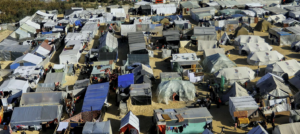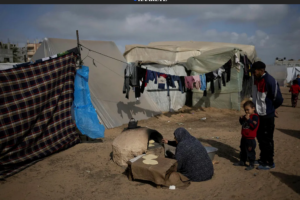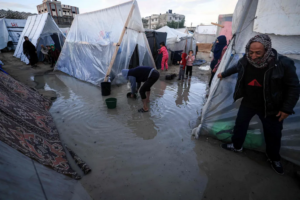Life in Gaza’s dystopian tent cities: ‘I feel like I’ve lost everything’

A tent ‘city’ with displaced Palestinians in Rafah, January 2024
Sheren Falah Saab reports in Haaretz on 30 January 2024:
“Anybody who has a tent is lucky. It’s hard to get a tent these days,” said Abeer, 43, who is living in a tent with her family in the southern Gaza city of Rafah near the Egyptian border. “There are 11 of us in one tent. It’s very cramped.”
Before the war, she lived with her husband and four children in the Nasser neighborhood of western Gaza City in the north. At the beginning of the war, she was displaced with her family to the city of Khan Yunis a bit north of Rafah. They stayed with relatives there until the beginning of December, when they were displaced a second time, to Rafah. They received a tent from the UNRWA refugee agency, and since then, that has been their home – with another displaced family.
According to UN figures, 1.7 million people – about 75 percent of the population of the Gaza Strip – have been displaced since Hamas’ October 7 attack and the beginning of the war. Satellite footage published this month in Haaretz shows tent cities in Rafah, where, according to the United Nations, around a million people are crowded.
“People are looking for tents because it’s the only available accommodation that can protect them from the rain, but it doesn’t shield you against the cold. Every day, people ask me how we got the tent; some of them improvise temporary tents from plastic sheets and empty flour sacks,” Abeer said in a video call.
“From the first day, we realized we needed iron or wooden poles to secure and stretch the tarpaulins. When the weather was stormy the tarps almost flew off. My husband managed to get four poles from a carpentry shop in Rafah, but now we’re looking for high-quality nails to secure the tarps so they won’t rip.”
In the video call, you could see sand around the tent, with children crying in the background and clothes hanging on a line. Before the war, Abeer worked as an assistant in a pharmacy in Gaza City. She said living in a tent is both a psychological and physical hardship.
“I feel like I’ve lost everything,” she said. “My whole life, 43 years in which I studied, worked, built a home with my husband and raised our kids there, was shattered in a single moment.” Noor al-Hilu, a 44-year-old mother of three from the Jabalya refugee camp near Gaza City, was displaced to Rafah and is living with her family in a tent. Her experience is similar to Abeer’s, as she told Israeli rights group B’Tselem.
“Now we’re here, in a 20-square-meter [215-square-foot] makeshift tent that we set up from fabric and blankets,” she said. “Thirty-two of us have been crowded into this tent, including 14 children – mine and my sister’s. At night we sleep tightly close to each other. It’s hard to sleep because of the crowding, the cold and the rain.”
The day starts rough. “Every morning we start searching for food and water again,” Al-Hilu said. “We begin the day by making dough for pita bread, and the children collect wood for the fire. We bake around 60 to 70 pitas, for everyone, on an iron surface.”

A Palestinian woman makes pita bread in the tents city in Rafah, January 2024
Then there’s the problem of clean water. “I send my children to fill water containers from the nearby school, but there’s never enough water – for drinking, laundry, minimal bathing or washing the dishes. We haven’t showered for a month and a half because of the lack of water,” Al-Hilu said, noting also the waiting line for the bathroom and the lack of hygiene products for women. “We use pieces of cloth and wash them after. The lack of water, of course, makes this difficult as well.”
Anas is living with his parents in a tent in Rafah. The last time he spoke to Haaretz it was about his displacement journey from the city of Deir al-Balah in central Gaza. Now he talks about the harsh life at his destination. ‘Some have no shoes; they walk barefoot in the mud. On rainy nights, I stay awake to check where there are leaks so we can fix them in the morning – close them up with sheets.’ “My parents are very cold at night,” he said. “I managed to get winter clothes from donations distributed to us, but it’s not enough. I got one blanket, so the three of us sit together to keep warm.”
Abeer also laments the rain. “The children get soaked and I don’t have extra winter clothes or a way to dry them. My youngest son, who’s 7, caught a cold and had a bad cough,” she said. “The situation is the same for other families with children. Some have no shoes; they walk barefoot in the mud. On rainy nights, I stay awake to check where there are leaks so we can fix them in the morning – close them up with sheets.”
Improvised routine
In a live broadcast from the tent city by Reuters, a father sits and makes food in a pot. He stirs it with a branch from a tree. Small children huddle around him, some of them barefoot. Each child takes his or her portion and returns to the tent. Next to the father sits a woman washing clothes by hand in a metal basin.
When asked by Haaretz what’s most lacking there, Abeer said: “In war there are different levels of suffering, and I think people living in tents suffer the most. I’m missing anything you can think about: kitchen utensils, soap, laundry detergent, a closet, underwear, bandages, shampoo, snacks for the children, a mirror, winter clothes, a good blanket, TV, games for the children. Everything.”
Even though the war leaves the Gazans in the tent city destitute, some are searching for meaning and trying to rebuild their lives. Dr. Fidaa al-Qurshali, who was displaced to Rafah at the beginning of the war from Gaza City’s Shujaiyeh neighborhood, has over the past two months turned her tent into a clinic where for free she provides first aid and basic medical care.

A displaced Palestinian uses a bucket to clear water in front of a tent drenched by heavy rain, at a makeshift camp in Rafah in the southern Gaza Strip on 27 January 2024
“The tents are very crowded. The news that there’s a doctor in a tent spread by word of mouth, and people come to get pain relievers and fever reducers for children, or to disinfect and bandage wounds. Because so many people were being referred to me, I decided to turn the tent into a clinic during the day,” she told an Arab media outlet.
“People here aren’t familiar with the city and they need urgent first aid. Some can’t go to the hospital because there are no cars to take them there. I also help pregnant women; I’ve already assisted two new mothers, helping them give birth in a tent.”
At the entrance to the tent there’s a sign in large Arabic handwriting: “The Clinic of Dr. Fidaa al-Qurshali.” “There’s no bed here for a patient, or a chair to sit on, or good lighting. I use the phone’s flashlight,” she told an Arab media outlet. Her medicine bottles and medical equipment sit on a wooden board.
“I contacted several sources to provide me with children’s medicine, things that can be given without a prescription,” she said. “For those who have a prescription, I try to help them obtain it, but it’s not always possible.”
A few hundred meters away is the tent of “Teacher Tariq.” In footage shown on Al Jazeera, children enter and leave the tent and talk about what they learned in the lesson. “When I heard that Teacher Tariq would teach us, I signed up for the class, because it’s important to me to keep learning and fulfill my dream of becoming a doctor,” 10-year-old Malek told Al Jazeera. “The studies in the tent gave me hope after I lost it when the war started, because we had no school and no teachers,” she said.
In an interview with the Arab media, Tariq Al-Ounabi described how he turned his tent into a classroom. Before the war, he was starting his career and had taught English for two years at an elementary school in the Zeitoun neighborhood of eastern Gaza City.
“The school was struck during the war, so the memories I had as a teacher with the students and teachers were obliterated,” he said. “We were displaced to Rafah, and I saw the children sitting all day and waiting for the time to pass. They have no daily schedule or structure. I wanted to help the children, to change the atmosphere and return a little to a normal routine.”
At night al-Ounabi sleeps in the tent that during the day becomes a classroom. The chairs and blackboard were borrowed from an UNRWA school in Rafah. The children write on small wooden erasable boards.
“I get responses from the kids who want to come to the tent and study. They ask me when the next class is,” he said. “My job right now is to convey a message to the children in Gaza that they’re like the rest of the children around the world and have the right to learn, even if it’s in a tent.”
This article is reproduced in its entirety
